How to Use A Japanese Toilet? A Beginner’s Guide to the Advanced Technology
When it comes to bathroom technology, Japan is known for its cutting-edge innovations. The toilet system is one of the most innovative and distinctive aspects of Japanese bathrooms. If you’ve never used one before, it can be overwhelming to navigate all the different buttons and settings.
But fear not! In this blog post, we’ll guide you through everything you need to know about “how to use a Japanese toilet?”. From basic functions like flushing to more advanced features like bidet functions and heated seats, we’ve got you covered. So take a seat, unwind, and explore the fascinating world of Japanese restrooms!
How to use a Japanese toilet?
Knowing how to use a Japanese toilet’s controls
Basic Functions
Japanese toilets often come with a variety of advanced features, but they also have basic functions that are similar to toilets around the world. A Japanese toilet should have the following fundamental features:
- Flushing: Like all toilets, Japanese toilets have a flushing mechanism that removes waste from the bowl. Some models allow you to adjust how much water is used for flushing with buttons or levers.
- Seat heating: The heated seats found in many Japanese toilets can be especially soothing during the chilly winter months.
- Deodorizing: Some models have built-in deodorizers that help reduce odors in the bathroom.
- Numerous Japanese toilets have sensors that open and close the lid automatically as you approach or leave the toilet.
- Night light: Some models have built-in night lights that illuminate the toilet bowl in low-light situations.
- Energy saving mode: To conserve energy, some Japanese toilets have an energy-saving mode that reduces power usage when the toilet is not in use.
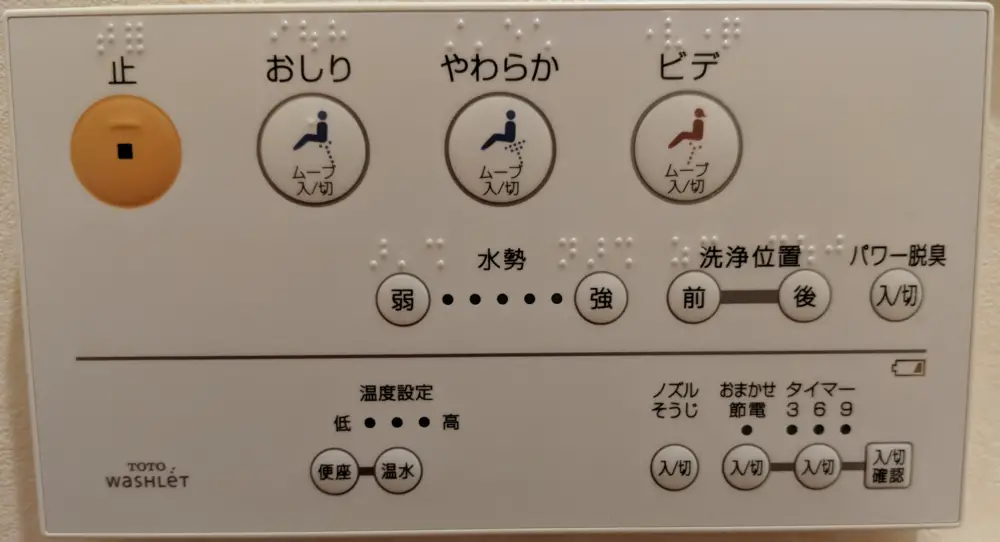
- Japanese toilets often come with a variety of advanced features, but they also have basic functions that are similar to toilets around the world. (Source: Internet)
While these are the essential functions of a Japanese toilet, many models also come with additional features like bidet functions, air drying, and massage options. To fully understand all of the features of your particular model, it is crucial to carefully read the instruction manual.
Useful Functions
Japanese toilets are known for their advanced features, which can make your bathroom experience more comfortable and hygienic. Here are a few helpful features you might discover on a Japanese toilet:
- Bidet function: Many Japanese toilets have a built-in bidet function that sprays water to help you clean yourself after using the toilet. For those who prefer a more thorough cleaning or have mobility issues, this feature is especially useful.
- Air drying: Some models also have built-in air dryers that can be used to dry yourself off after using the bidet function. This eliminates the need for toilet paper and is more environmentally friendly.
- Adjustable water pressure and temperature: Most bidet functions allow you to adjust the water pressure and temperature to your liking.
- Massage options: Some models come equipped with massage options that use water or air to provide a gentle massage to your posterior.
- Automatic seat opening/closing: To avoid touching the toilet seat, many models have sensors that automatically open and close the lid when you approach or walk away from the toilet.
- Water-saving mode: To conserve water, some Japanese toilets have a water-saving mode that reduces the amount of water used for flushing.
- Deodorizing: Some models have built-in deodorizers that reduce unpleasant odors in the bathroom.
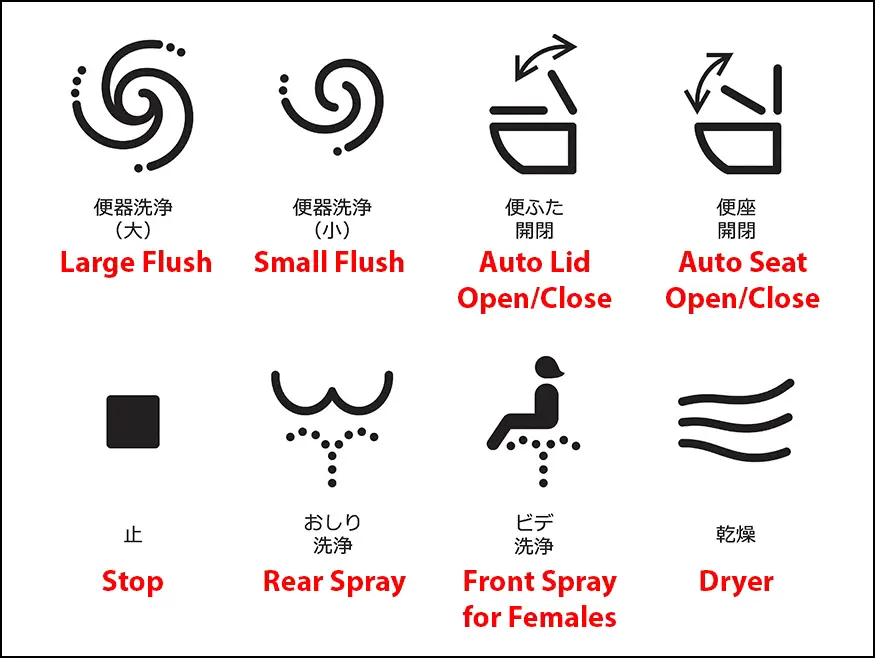
- Japanese toilets are known for their advanced features, which can make your bathroom experience more comfortable and hygienic. (Source: Internet)
These are just a few of the many advanced features you may find on a Japanese toilet. To properly use each function, it’s crucial to carefully read the instruction manual.
Advanced Functions
In addition to the basic and useful functions, Japanese toilets also have advanced features that make them unique. Here are some of the advanced functions you may find on a Japanese toilet:
- Automatic seat warming: In addition to heated seats, some models have sensors that detect when you’re approaching the toilet and automatically warm up the seat for you.
- Some models include a remote control that you can use to change settings like the water pressure, temperature, and massage options.
- Sound effects: To maintain privacy, some models have built-in sound effects that can be activated during use.
- Self-cleaning: Some models have a self-cleaning function that uses electrolyzed water or some other cleaning agent to clean the bowl and nozzles after each use.
- UV sanitization: To further enhance hygiene, some models have built-in UV lights that sanitize the toilet bowl and nozzles.
- Energy-saving features: Many models have energy-saving features that reduce power usage when the toilet is not in use.
- App integration: Some high-end models can be controlled through a smartphone app, allowing you to customize settings even when you’re not at home.
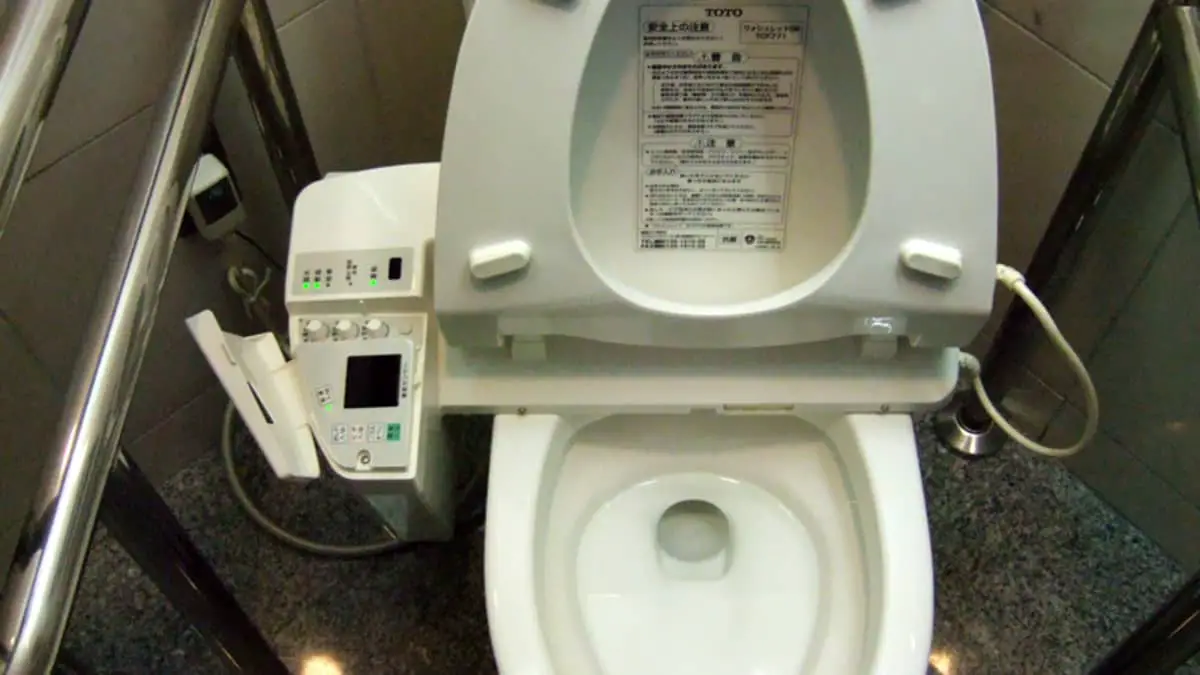
- In addition to the basic and useful functions, Japanese toilets also have advanced features that make them unique. (Source: Internet)
These advanced functions may not be available on all Japanese toilets, and they can vary greatly depending on the model and brand. To learn about all the features of your particular toilet, be sure to carefully read the instruction manual.
Japanese Public Toilets
Japanese public toilets are known for their cleanliness and advanced technology. The following are some amenities you might discover in Japanese public restrooms:
- High-tech toilets: Many public toilets in Japan are equipped with high-tech toilets that have advanced features like bidet functions, heated seats, and air drying. Some even have sound effects and self-cleaning mechanisms.
- Public restroom cleanliness: Japanese restrooms are frequently spotless and well-maintained. The facilities in many restrooms are routinely cleaned and sanitized throughout the day by attendants.
- Accessibility: Japanese public toilets are often designed to be accessible for people with disabilities, with larger stalls and grab bars.
- Baby-changing stations: Many public restrooms in Japan have baby-changing stations for parents with young children.
- Privacy: To provide privacy, many public toilets in Japan have doors that go all the way down to the floor, preventing any gaps or openings.
- Shoe lockers: In some public restrooms, you’ll find shoe lockers where you can store your shoes before entering the toilet area. This is a common practice in Japan, as it helps keep the restroom floors clean and hygienic.
- Gender-neutral restrooms: Increasingly, public restrooms in Japan are being designed as gender-neutral, providing more privacy and comfort for all users.
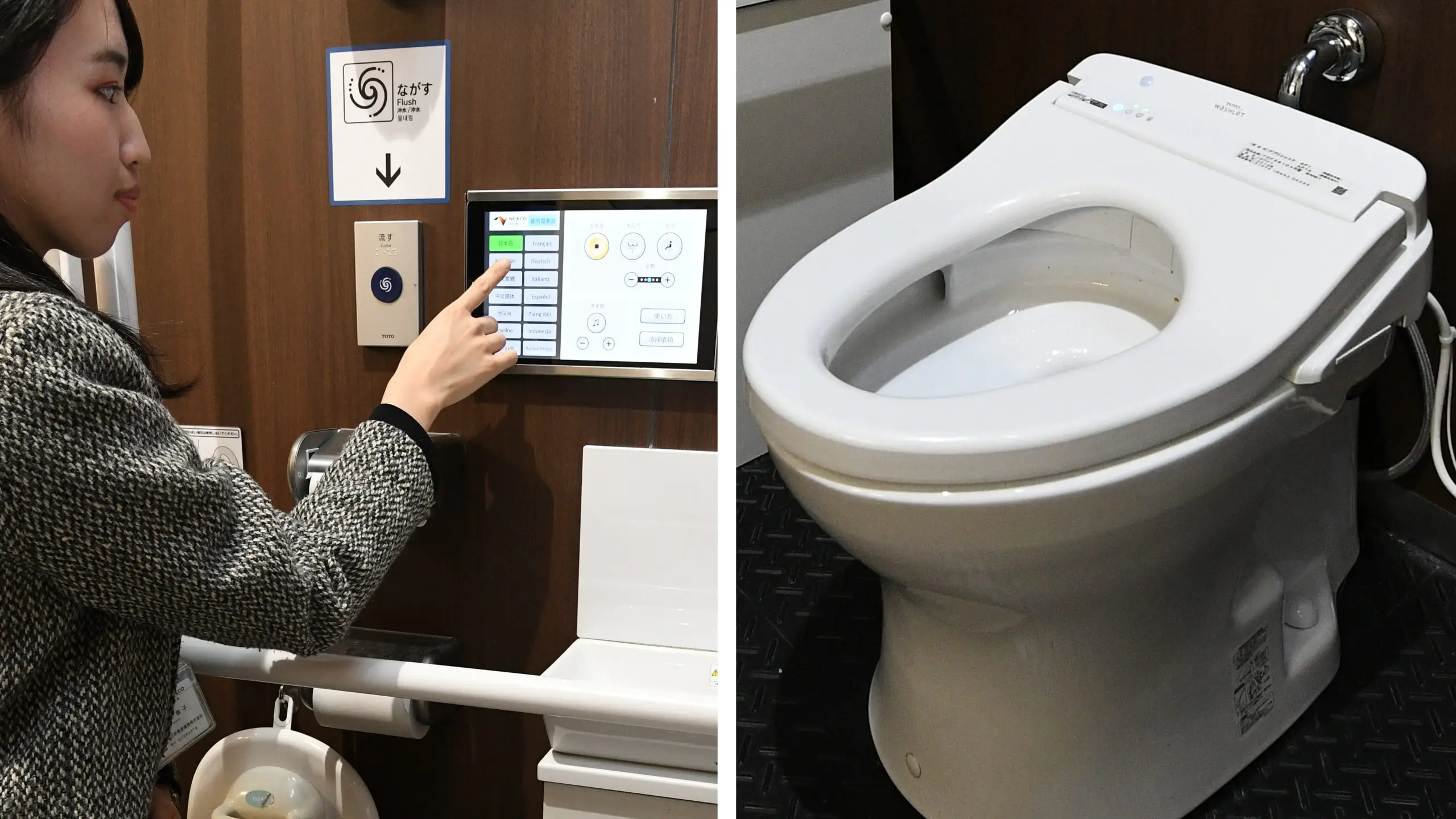
- Japanese public toilets are well-maintained, hygienic, and equipped with advanced technology to make the bathroom experience more comfortable and convenient. (Source: Internet)
Overall, Japanese public toilets are well-maintained, hygienic, and equipped with advanced technology to make the bathroom experience more comfortable and convenient.
How to use a Japanese toilet?
Guide to Manners Japanese toilets
Using a Japanese toilet can be a unique and enjoyable experience, but it’s important to keep in mind certain etiquette guidelines. Here are some pointers for respecting the culture and using a Japanese restroom:
- Remove your shoes: Place your shoes in the designated shoe lockers before entering the restroom area.
- Be mindful of cleanliness: Many Japanese toilets are equipped with bidet functions and air dryers, which can eliminate the need for toilet paper. However, if you do use toilet paper, be sure to dispose of it properly in the provided trash bin.
- Don’t flush anything other than toilet paper: In order to prevent clogging, it’s important to only flush toilet paper down the toilet. Baby wipes, feminine hygiene products, and other items should never be flushed.
- Use the appropriate stall: Some Japanese restrooms have different stalls for men and women, while others have gender-neutral stalls. Make sure to use the appropriate stall for your gender or follow the signage provided.
- Wash your hands: As always, be sure to thoroughly wash your hands with soap and water after using the restroom.
- Respect privacy: To respect the privacy of others, avoid taking phone calls or talking loudly in the restroom area.
- Japanese public restrooms are typically very clean and well-maintained, so keep them that way. To help maintain this standard, avoid littering or leaving a mess in the restroom area.
By following these etiquette guidelines, you will show respect for the Japanese culture and help maintain the cleanliness and comfort of the restroom facilities.
You can also like:
- How to Use Washing Machine in Japan — Guide to Living in Japan
- How to Get a Psychology Job in Japan – Job Opportunities For Foreign
Fun fact
A fun fact about using a Japanese toilet is that many models come equipped with sound effects to provide privacy and reduce embarrassment. These sound effects, known as “Otohime” in Japanese, can be activated by pressing a button on the control panel. The sound effects can range from electronic music to the sound of a flushing toilet, and they are meant to mask any noise made during use.
This feature is especially popular among women, who may feel embarrassed to make noise in public restrooms. Some high-end toilets even have built-in speakers that play soothing music or nature sounds to create a more relaxing environment. Overall, the sound effects feature adds an extra layer of comfort and privacy to the bathroom experience.
How to Find A Toilet in Japan?
Finding a toilet in Japan is generally not difficult, as there are public restrooms located throughout the country. Here are some pointers for using the restroom in Japan:
- Look for signs: In public areas such as train stations, shopping malls, and parks, there are usually signs indicating the location of restrooms. Look for symbols of a man or woman to identify gender-specific restrooms.
- Use convenience stores: Convenience stores like 7-Eleven and Lawson can be found all over Japan and usually have clean and well-maintained restrooms that customers can use.
- Train stations: Most train stations in Japan have restrooms, although they may be crowded during peak hours. Some train stations even have high-tech toilets with advanced features.
- Department stores: Department stores like Mitsukoshi and Isetan also have restrooms that are usually clean and comfortable.
- Public parks: There are restrooms available for visitors to use in many public parks in Japan.
- Use smartphone apps: There are smartphone apps available that can help you find public restrooms in Japan, such as “Toilet Finder” and “Japan Toilet”.
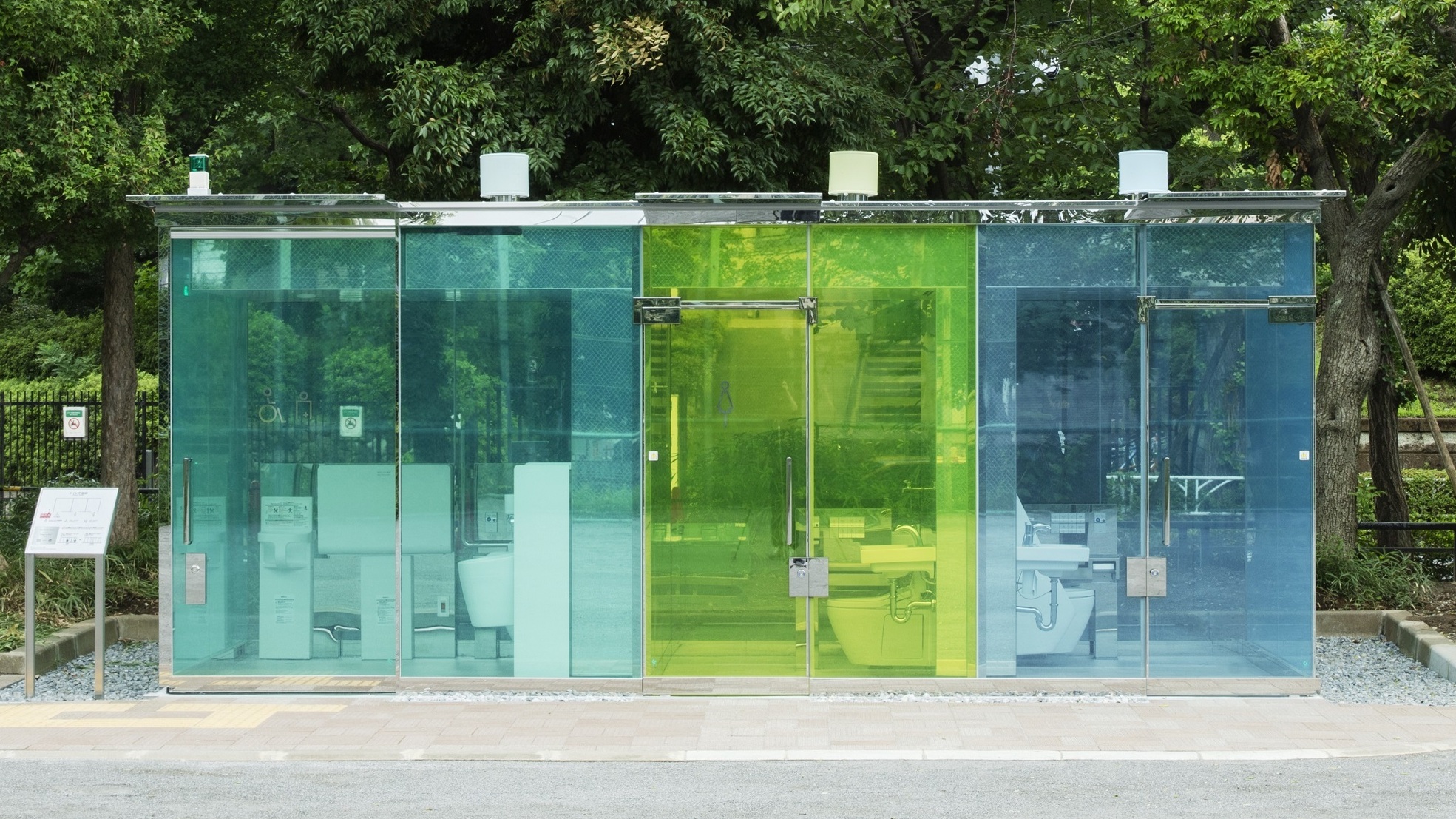
- Finding a toilet in Japan is generally not difficult, as there are public restrooms located throughout the country. (Source: Internet)
Overall, finding a toilet in Japan should not be a major issue, as there are many options available throughout the country. Just keep an eye out for warning signs, and don’t be shy about asking for help if you need it.
Japanese toilet types
There are several types of toilets that you can find in Japan. Some of the most typical types are listed below:
- Western-style toilet: This type of toilet is similar to what you would find in most Western countries, with a seat and a flushing mechanism.
- Japanese-style toilet: Also known as “squat toilets,” these toilets are built into the floor and require the user to squat down to use them. Both traditional Japanese homes and public restrooms frequently contain them.
- High-tech toilet: These toilets are equipped with advanced features such as bidet functions, heated seats, and air drying. Some models even have sound effects and self-cleaning mechanisms.
- Portable restrooms: These are short-term restroom facilities used at outdoor gatherings, building sites, and disaster relief locations. They are designed to be easily moved and are usually self-contained, meaning they don’t require any external plumbing or sewage connections.
- Eco-friendly toilet: These toilets are designed to conserve water and reduce waste. They may use composting or incineration to dispose of waste, eliminating the need for traditional plumbing.
In addition to these types, there are also gender-specific and gender-neutral restrooms available in Japan. Overall, the variety of toilet options in Japan reflects the country’s commitment to hygiene and innovation in restroom technology.
Ten Important Facts About Japanese Toilets
- High-tech features: Japanese toilets are renowned for their advanced features, such as bidet functions, heated seats, and air drying.
- Sound effects: Some Japanese toilets have built-in sound effects to provide privacy and reduce embarrassment.
- Shoe lockers: In some public restrooms, you will find shoe lockers where you can store your shoes before entering the toilet area.
- Low-flush toilets: To conserve water, many Japanese toilets have a low-flush option that uses less water than traditional toilets.
- Public cleanliness: Japanese public toilets are typically very clean and well-maintained, with attendants who regularly clean and sanitize the facilities.
- Squat toilets: Japanese-style squat toilets are still common in some public restrooms, especially in rural areas.
- Toilet slippers: Some homes and guesthouses in Japan may provide special slippers to be worn when using the bathroom, which should not be worn outside of the restroom.
- Automatic seat opening/closing: Many Japanese toilets have sensors that automatically open and close the lid when you approach or walk away from the toilet.
- Privacy features: To respect privacy, many public toilets in Japan have doors that go all the way down to the floor, preventing any gaps or openings.
- Baby-changing stations: Many public restrooms in Japan have baby-changing stations for parents with young children.
Overall, Japanese toilets are known for their cleanliness, innovation, and attention to detail, making them one of the most unique and enjoyable aspects of the country’s culture.
FAQs
1. How is a Japanese toilet cleaned?
Cleaning a Japanese toilet is similar to cleaning any other type of toilet, but with some additional considerations for the advanced features. Here are some steps you can follow:
- Turn off the power: If your Japanese toilet has any electrical components, such as heated seats or bidet functions, be sure to turn off the power before cleaning.
- Wipe down exterior surfaces: Use a damp cloth or sponge to wipe down the exterior surfaces of the toilet, including the seat, lid, and control panel. You can use a mild detergent if necessary.
- Clean the bowl: Use a toilet brush and a toilet bowl cleaner to clean the inside of the bowl. Be sure to scrub under the rim and around the nozzles if your toilet has bidet functions.
- Clean nozzle area (if applicable): If your toilet has a bidet function, make sure to clean the nozzle area thoroughly with a soft, non-abrasive cloth. For added hygiene, you might also want to use a disinfectant spray or wipe.
- Dry the toilet: Use a dry cloth or paper towel to dry the exterior surfaces of the toilet, including the control panel and nozzles if applicable.
- Turn the power back on (if applicable): Once you have finished cleaning, turn the power back on to any electrical components that were turned off.
To maintain cleanliness and avoid odors, your Japanese toilet needs to be cleaned frequently. Be sure to read the manufacturer’s instructions for any specific cleaning recommendations based on your toilet model.
2. What advantages do Japanese toilets offer?
- Advanced features: Japanese toilets are known for their advanced functions, such as bidet functions, heated seats, and air drying, which can provide increased comfort and hygiene.
- Hygiene: Japanese toilets often have self-cleaning mechanisms, UV sanitization, and other features that help keep the toilet clean and hygienic.
- Water efficiency: Many Japanese toilets are designed to be water-efficient, using less water than traditional toilets.
- Comfort: Japanese toilets are made with the user’s comfort in mind and include features like heated seats and sound effects.
- Accessibility: Some models are designed to be accessible for people with disabilities, with larger stalls and grab bars.
- Environmentally friendly: Eco-friendly options like composting toilets and low-flush toilets are becoming more common in Japan, helping to reduce waste and conserve resources.
- Technology integration: Some models have app integration, allowing users to control various settings via smartphone or tablet.
Overall, the benefits of using a Japanese toilet include improved hygiene, increased comfort, and advanced technology.
4. Are Japanese toilet green?
Yes, Japanese toilets can be eco-friendly in a number of ways. Here are some examples:
- Low-flush toilets: Many Japanese toilets have a low-flush option that uses less water than traditional toilets, saving water and reducing household water bills.
- Composting toilets: Some eco-friendly Japanese toilets use composting technology to convert human waste into fertilizer, eliminating the need for external plumbing or sewage connections.
- Energy-saving features: Many high-tech Japanese toilets include energy-saving features such as timers and motion sensors to conserve electricity.
- Smart technology: Some models have integrated smart technology and can be controlled remotely via smartphone or tablet, allowing users to monitor water usage and adjust settings to reduce consumption.
- Water-conserving bidet functions: Japanese toilets often come with a bidet function that uses water to cleanse instead of toilet paper, which can save trees and reduce waste.
Overall, Japanese toilets are often designed with eco-friendliness in mind and offer a range of options for environmentally conscious consumers.
5. Are toilets in Japan self-cleaning?
Yes, many Japanese toilets have self-cleaning mechanisms that help to keep the toilet clean and hygienic. Here are some examples of self-cleaning features that may be included in a Japanese toilet:
- Automatic flushing: Some models have sensors that automatically flush the toilet when you stand up, reducing the need for manual flushing.
- UV light sanitization: Many Japanese toilets have a UV light built-in that is designed to sanitize the toilet bowl and seat after each use.
- Self-cleaning nozzles: Japanese toilets with bidet functions often have self-cleaning nozzles that rinse themselves with water before and after use.
- Pre-misting: Some models pre-mist the toilet bowl with water before use, which can help prevent waste from sticking and reduce the need for scrubbing.
- Air purification: High-end Japanese toilets sometimes include air purification systems that help eliminate odors and keep the bathroom smelling fresh.
While not all Japanese toilets have these features, many do come equipped with advanced technology that helps to keep the toilet clean and hygienic without requiring much effort from the user.
6. Are Japanese toilets electrically powered?
Some Japanese toilets do require electricity to operate, particularly those with high-tech features such as bidet functions, heated seats, and air drying. These features rely on electrical components to function properly.
However, there are also Japanese toilets available that do not require electricity to operate, such as traditional squat toilets and low-flush toilets. Composting toilets, which use a natural process to break down waste and convert it into fertilizer, also do not require electricity or external plumbing.
If you’re thinking about buying a Japanese toilet, make sure to read the model specifications to see if electricity is needed. If you’re looking for an eco-friendly option but still want some of the advanced features of a Japanese toilet, consider models with energy-saving features like timers and motion sensors to help conserve electricity.
7. Are toilets in Japan automated?
Yes, many Japanese toilets are automatic and come with sensors that activate various features. Here are some examples of the automatic functions you might find in a Japanese toilet:
- Automatic lid opening/closing: Some models have sensors that detect when someone approaches or leaves the toilet, causing the lid to open and close automatically.
- Automatic flushing: Many Japanese toilets have sensors that detect when someone stands up, triggering an automatic flush.
- Automatic bidet function: Some models have sensors that can detect your weight and adjust the spray angle and water pressure accordingly.
- Automatic deodorizing: High-tech Japanese toilets sometimes include an automatic deodorizing system that activates when you sit down on the seat.
- Automatic cleaning: Certain models have self-cleaning mechanisms that activate after each use, helping to keep the toilet clean and hygienic.
Overall, Japanese toilets are often designed to be user-friendly and convenient, with many automatic features that eliminate the need for manual operation.
Conclusion
Finally, despite initially seeming intimidating, using a Japanese toilet is actually quite easy. Here are the basic steps to follow:
- Take off your shoes before entering the restroom area.
- Choose the appropriate stall and adjust the seat if necessary.
- If a bidet is available, use it and customize the temperature and pressure of the water.
- Rinse off (if available).
- After flushing the toilet, thoroughly wash your hands with soap and water.
Remember that these are just general guidelines and the exact instructions may vary depending on the specific model of your Japanese toilet. Be sure to read the instruction manual or ask for assistance if you’re unsure “how to use a Janpanese toilet?”. With its advanced features and attention to hygiene, a Japanese toilet can provide a comfortable and enjoyable bathroom experience.









